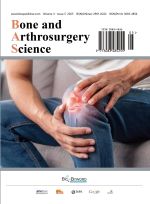Clinical Observation of Anterolateral Thigh Perforator Flap for Reconstruction of Head and Facial Soft Tissue Defects
Abstract
Objective: To evaluate the efficacy of the anterolateral thigh perforator flap in repairing head and face skin defects. Methods: Nineteen patients with head and facial skin defects, admitted to the 303rd Hospital and the 89th Hospital of the People’s Liberation Army from May 2012 to May 2020, were selected as research subjects and underwent repair surgery. The primary method employed was free transplantation of the anterolateral thigh perforator flap. Following the operation, patients were closely monitored for 5 to 7 days. The viability of the blood vessels was assessed based on the healing, color, and vascular filling of the flaps. Patients were followed up for 6 to 18 months post-operation to evaluate the donor and recipient sites. Results: Out of the 19 transplanted flaps, 18 survived completely, yielding a survival rate of 94.73%. The recurrence rate of the original lesion post-operation was 10.52%. 94.44% of patients reported no impact on lower limb movement on the side where the flap was harvested, and only 16.66% of patients experienced noticeable numbness in the donor site skin after the operation. All 19 patients reported that initially, the flaps were stiff and had limited movement. However, after 6 months, they gradually softened and adhered more closely to the original skin tissue. Conclusion: The free anterolateral femoral perforator flap is an ideal option for repairing head and facial defects. It offers a reliable blood supply, a large harvestable area, and minimal impact on both donor and recipient sites. Its abundant blood supply remains unaffected by the repair surgery, resulting in a relatively high survival rate. It demonstrates good adaptability and is more readily accepted by patients.
References
Zhao W, Ye J, Yang E, 2011, Repair of Skin Defects After Resection of Skin Tumors in the Head, Face, and Neck Using Local Skin Flaps. Chinese Journal of Aesthetic Medicine, 20(10): 1508–1510.
Ai Q, Zhang Z, Xiang H, 2017, Application of Adjacent Miniature Skin Flaps in the Repair of Facial Skin Defects. Journal of Clinical Otorhinolaryngology Head and Neck Surgery, 2017(14): 1100–1102.
Hsieh C, Yang E, Kuo Y, et al., 2003, Free Anterolateral Thigh Adipofascial Perforator Flap. Plastic & Reconstructive Surgery, 112(4): 976–982.
Li L, Wang D, Wang W, 2011, Application of Local Skin Flaps in the Repair of Facial Skin and Soft Tissue Defects. Bethune Medical Journal, 9(5): 350–351.
Feng Y, Li W, Wang N, 2010, Local Anatomy of the Tensor Fasciae Latae Perforator Flap and Its Significance in Head and Neck Repair. Basic & Clinical Medicine, 30(2): 151–154.
Kimata Y, Uchiyama K, Ebihara S, et al., 2000, Anterolateral Thigh Flap Donor-Site Complications and Morbidity. Plast Reconstr Surg, 106(3): 584–589.
Liu W, Liu X, Li H, 2008, Application of Anterolateral Thigh Perforator Flaps in Head and Neck Surgery. Proceedings of the Fifth Chinese Oncology Academic Conference, the Seventh Cross-Strait Oncology Academic Conference, the International Society for Cellular and Gene Therapy in Oncology Conference, and the Second Sino-Japanese Academic Conference on Tumor Interventional Therapy.
Tang M, Zhang W, Zhang S, 2011, Research Progress on Perforator Flaps. Chinese Journal of Clinical Anatomy, 29(6): 602–606.
Li W, Xu Z, Cheng Y, 2012, Application of Free Anterolateral Thigh Perforator Flap for Reconstruction of Defects After Radical Resection of Head and Neck Tumors. Stomatology, 32(5): 286–289.
Tang M, Xu Y, Zhang S, 2013, Applied Anatomy and Clinical Practice of Perforator Flaps. Science Press.
Lu M, Sun G, Hu Q, et al., 2015, Functional Assessment: Free Thin Anterolateral Thigh Flap Versus Free Radial Forearm Reconstruction for Hemiglossectomy Defects. Medicina Oral Patologia Oral Y Cirugia Bucal, 20(6): e757.
Xu D, 2006, Advances in Anatomical Research and Clinical Application of the Anterolateral Thigh Flap. National Microsurgery Academic Conference and International Microsurgery Symposium.
Huang Y, Hsieh T, Lai C, et al., 2014, In Situ Pedicle Lengthening of the Anterolateral Thigh Flap. Plast Reconstr Surg, 133(1): 85e–87e.
Lutz B, Wei F, Chen H, et al., 1998, Reconstruction of Scalp Defects with Free Flaps in 30 Cases. Br J Plast Surg, 51(3): 186–190.

